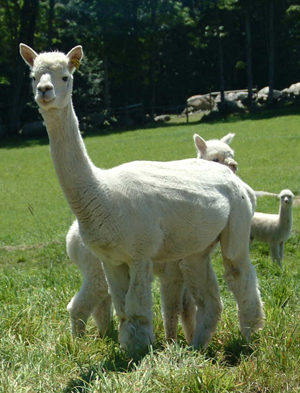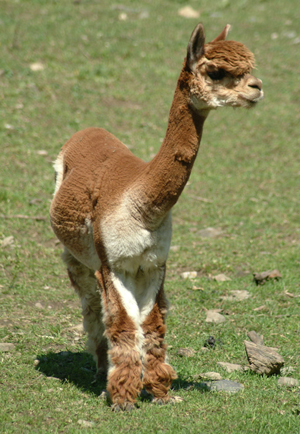Observations on the Geriatric Female Alpaca, Part 1 (reprinted from Cas-Cad-Nac Farm Chronicles, Spring 2010)

What follows below is a reprint of the final husbandry article that appeared in the Spring 2010 issue (the final hardcopy produced) of Cas-Cad-Nac Farm Chronicles. For those of you that haven’t seen it before, here you go. For those of you that have already read it, my apologies. Again. If nothing else, I figure that posting it here on the blog might light a fire beneath the arse of that ne’er-do-well alpaca breeder who has been promising you a followup article since April! Now where has that schmuck run off to? -IL
One of the fascinating things about raising alpacas over the past 13+ years has been the realization that we as an industry and a community don’t, when it comes right down to it, really know all that much about what makes these animals tick. Relative to other domesticated species who have been studied for ages, much of what we know (or what we think we know) about the health and management of alpacas is being learned on the fly. While we have definitely learned much over the past couple of decades, it is still not uncommon for perfectly reasonable and highly educated professionals to have completely divergent views on various issues, simply based upon what they have observed and experienced.
All of that is doubly true where the geriatric alpaca is concerned. The fact of the matter is that alpacas in South America don’t live out their natural life cycle the vast majority of the time, most often culled as a food animal at a relatively young age. While we can (and do) draw to a great degree from the knowledge base of the llama world when thinking about geriatric alpacas, the first appearances of older alpacas en masse is really a North American phenomenon of the last decade. Over the last 5 to 10 years those first animals that were imported in the mid 80s and onward have for the first time been hitting their late teens in large numbers or as the case may be, not hitting their late teens, though more on that below. Thankfully, as a species that is originally adapted to life in a rather unforgiving habitat, the Andean Altiplano, alpacas tend to be very forgiving of what amounts to a lot of conjecture and educated guessing on the part of their human caretakers!
We have been blessed over the past 10+ years to have had a core of our foundation herd here at Cas-Cad-Nac made up of imported females. Though mostly from Peru, there have also been a couple of highly valued first generation Chilean-Americans (it’s the PC term you know!) in the mix as well. Many of those girls are now between 13 and 16 years old and some, based on dentition, we suspect considerably older. Several others we have already lost along the way to what can only be considered natural causes. Remember that when the animals were originally imported they were to some degree arbitrarily designated a date of birth and in some cases that DoB was more accurate than in others. What follows here are really just some things we’ve seen with those older females. I’ve decided to break this down into two parts: this time around touching more on the questions of nutritional management at it relates to production. We’ll cover other non-repro stuff (conformational issues playing themselves out, arthritis, “old lady” bumps, cataracts, etc…) in the summer edition of CCNF Chronicles. In any case this is by no means intended to be an all-encompassing list of the issues one encounters with older alpacas, just our experiences within the herd (which for trivia’s sake numbers +/- 220 animals) here at CCNF since 1997. It is also important to note that while our warm months—generally May through September—are comparable to many other parts of North America, our winters here in northern New England often have a nasty edge to them (cold + humidity) that sets us apart. To say that those cold stretches affect how we manage our herd, and particularly the older members of it, would be an understatement. Just something to bear in mind…
So let us dispense with one thing right off the bat. When we first looked into the industry in 1994 there were shiny brochures proclaiming that alpacas would live for 20 to 25 years and have a cria every year from 18 months of age onward. If there is anyone out there still bandying about that yarn as the Gospel Truth please send them hither as I have a bridge in Brooklyn I need help selling as well. The one thing that has become very apparent here is that the average natural life span of a production female is really much closer to 15 years of age. And, no, they will generally not have a cria every year. In fact we figure if we can get an average of 6 to 8 live crias out of every female in their reproductive life span that is about average.

Defining when a female will become “geriatric” is also not an easy thing to pinpoint and will vary greatly from one animal to another. Some alpacas will start to show real wear and tear as young as 7 or 8, while others (see left and above) are seemingly chugging along at 16+ really looking and behaving no differently than they did at the age of 10. So what are the things we are looking for in these females? Particularly where the question of their reproductive viability is concerned we really want to see that they are still able to maintain a healthy body condition while going through the dual trial of nursing one cria and growing another inside. That requires that their gut be fully (or mostly) functioning, a good appetite, and that their teeth be in good shape too. If the food goes down the proverbial hatch not properly chewed, it puts the rest of the process off too after all. It is not uncommon for us to give one of these older dams a year off to gain a reserve of body condition allowing them to deal with just one cria at a time (first as a pregnancy, then nursing them as opposed to both at once). We will also often try to get those females birthing out during the warm months when the days are mild and the grass is lush. For a female who might otherwise be at some disadvantage, we want there to be as easy and readily available a supply of calories as possible. An older female that tends to run on the thin side anyway will have a far easier time managing a chubby little cria that is nursing aggressively if they are not having to also expend energy (calories) shivering to stay warm. Common sense I know but many a story have we heard about formerly good dams whose milking ability has suddenly gone away. The vast majority of the females in those cases are malnourished and under-conditioned.
We will grant though that sometimes there is little one can do to improve on an older animal’s ability to process the nutrition they do get access to. Though the most common challenge we are finding in those females is their teeth wearing down or away (both incisors and molars), sometimes in truly older critters the gut also loses its efficiency as well. Animals that would have maintained healthy body condition on 2 cups of grain, pasture, and free-choice hay just a few years before find themselves struggling to hold condition no matter how many calories you throw at them. For our geriatric girls with dentition issues we have had some success nursing them along with pelletized hay which they are able to handle a little better than the real thing, though even that has shown to have had its limitations. Of the identifiable natural causes of death in older alpacas cancer in various forms seems to be a fairly prevalent one as do kidney and liver failure. Though in the cases of the latter two there are often questions about whether they are the cause or more of a symptom triggered by some other disease or event, even if the “event” in question is really just old age. Leaving that bad stuff aside, it is important to note that females that are in healthy condition are not only more likely to bear and suckle young without complications but we’ve also found (another “duh!” moment) that older females in good shape generally are easier to rebreed, have fewer complications giving birth (because they are strong), and resist and tolerate parasites better because they have a good immune system. The bottom line: they are a lot less work. Strong older moms in good body condition make for healthy, easily managed newborn crias. Unhealthy, malnourished, and under-conditioned older moms make bottle babies. Guess which model we prefer? Well cared for your older females are still very capable of producing some amazing crias: they may just need a little extra TLC to do it! All hail the (older) goose that lays the golden egg!

Thanks for the article. I have a Chilean import of unknown years now. We nicknamed her Grandma Reina. It has taken us some time to get her to allow us even close to her but she has a spot in my heart as the years with her have gone by. Guess is she is near 17 and starting to look it. She is great with the crias and we will allow her to last out her days in the same pen with them.